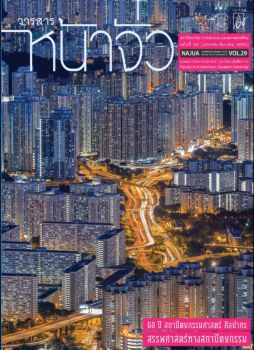“ผามฟ้อนผี” เวทีแห่งพิธีกรรมความเชื่อ กับการปรับตัวในบริบทสังคมร่วมสมัย
Keywords:
ผามฟ้อนผี, สถาปัตยกรรมเฉพาะกิจ, วัฒนธรรม, ความเชื่อ, Paam Fohn Pi, Specific Architecture, Culture, BeliefsAbstract
บทความนี้มีวัตถุประสงค์เพื่อแสดงถึงการปรับตัวของ “ผามฟ้อนผี” สิ่งก่อสร้างพื้นถิ่นเฉพาะกิจที่ทำหน้าที่เป็นเวทีแห่งพิธีกรรมทางความเชื่อ ซึ่งมีรูปแบบพื้นที่ใช้สอย องค์ประกอบทาง สถาปัตยกรรม และคุณค่าทางสุนทรียภาพที่สอดรับกับพิธีกรรมและคติความเชื่อ ได้แก่ ผามฟ้อน ผีมด ผีเม็ง ผีมดซอนเม็ง ผีเม็งนํ้าฮ้า ผีอารักษ์ และผีเจ้านาย ซึ่งยังคงสามารถดำรงอยู่ได้ในยุคสมัยที่ มีการเปลี่ยนแปลงทางสภาพสังคมและเศรษฐกิจ รวมไปถึงการศึกษาที่มุ่งเน้นการให้เหตุผลตามหลักวิทยาศาสตร์แทนคติความเชื่อเรื่องผีและจิตวิญญาณ ทำให้การฟ้อนผีถูกลดบทบาทที่มีต่อสังคมลง กลายเป็นเพียงวัฒนธรรมของคนกลุ่มย่อย
การศึกษาพบว่า นอกจากจะมีผามฟ้อนผีตามรูปแบบจารีตดั้งเดิมที่เคยรับรู้แล้ว ยังมีผาม รูปแบบอื่นๆที่ถูกปรับตัวไปตามบริบทสังคมปัจจุบัน ไม่ว่าจะเป็นระบบทุนนิยมที่เข้ามามีบทบาทต่อการใช้วัสดุอุตสาหกรรมในการก่อสร้าง ส่งผลให้รูปแบบของผามเปลี่ยนแปลงไปเป็น “ผามเต็นท์” และ “ผามถาวร” หรือการใช้วัสดุทดแทน ซึ่งตอบสนองต่อความสะดวกรวดเร็วและประหยัดค่าใช้จ่ายในการจัดพิธีฟ้อนผี ในขณะเดียวกันก็มีแนวคิด “เสรีนิยมใหม่ (Neoliberal)” ซึ่งปลุกกระแสการเรียนรู้ตัวตนของกลุ่มชาติพันธุ์ ซึ่งเป็นกลุ่มวัฒนธรรมย่อยในสังคม ส่งผลให้มีการฟื้นฟูรูปแบบผามฟ้อนผี แบบจารีตดั้งเดิมให้มีบทบาทมากขึ้น กลายเป็นตัวแทนของอัตลักษณ์วัฒนธรรมการฟ้อนผีที่แสดงให้เห็นคุณค่าและความสวยงามตามภูมิปัญญาที่สืบทอดกันมา นอกจากนั้นยังมีการปรับเปลี่ยนรูปแบบของผามแบบจารีตให้สามารถตอบสนองความต้องการของม้าขี่ โดยเฉพาะม้าขี่ผีเจ้านายที่มีจำนวนมากขึ้น เกิดเป็นผามที่มีการหลอมรวมวัฒนธรรมฟ้อนผี ทั้งม้าขี่สายผีมด ผีเม็ง และผีเจ้านายเอาไว้ในผามเดียวซึ่งแสดงให้เห็นว่า นอกจากแนวโน้มการดำรงอยู่ของผามฟ้อนผีที่ขึ้นอยู่กับความเชื่อเรื่องการนับถือผีและการฟ้อนผีแล้ว ยังขึ้นอยู่กับการเลือกใช้และการเห็นคุณค่าของคนในวัฒนธรรมที่จะเลือกหยิบใช้รูปแบบผามและวัสดุให้เหมาะสมกับตนเองและบริบททางสังคมอีกด้วย
The Adaptation of “Paam Fohn Pi”: stage of Rituals and Beliefs in contemporary context
Amarit Muenseetha
Master Degree Student in Vernacular Architecture Program
Faculty of Architecture, Silpakorn University
Kreangkrai Kirdsiri, Ph.D.
Lecturer, Department of Architecture
Faculty of Architecture, Silpakorn University
The purpose of this paper is to show the adaptation of “Paam Fohn Pi”, the specific architecture (marquee) which related to Ancestor Trance Dance in Northern Thailand, as the stage of Rituals and Beliefs which has value of appearance, functional space, architecture’s elements and aesthetics. Kinds of Ancestor Trance Dance’s marquees are Paam Fohn Pi-Mod, Pi-meng, Pi-Mengnaamha, Pi-Modsornmeng, Pi-Arrak and Pi-Chaonai can still being found at present, but they have been reduced role from folk society because of social, economic and scientific perspective factors.
The research revealed that “Paam Fohn Pi” has various forms which have been adapting along the time. In contemporary context, not only traditional styles of marquee are found, but also the contemporary styles which are affected from Capitalism such as “Tent”, “Permanent Marquee” and “Renewable Materials Marquee” are increasingly found. Meanwhile, Neoliberalism has encouraged ethnic consciousness of folk society to restore Paam Fohn Pi’s traditional style as a symbolic of Ancestor Trance Dance’s identity, which has value and aesthetics of folk wisdom. Moreover, it has been adapted to support the variety of Ancestor Trance Dance “Pi-Mod”, “Pi- Meng” and “Pi-Chaonai” in one marquee. All of these adaptations show that, not only existence of “Paam Fohn Pi” depend on Ancestor Trance Dance’s appreciation, but also depend on realization of specific architecture’s value and relationship between materials and social context, from people in this culture.





